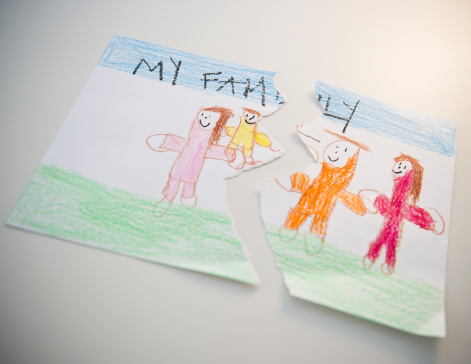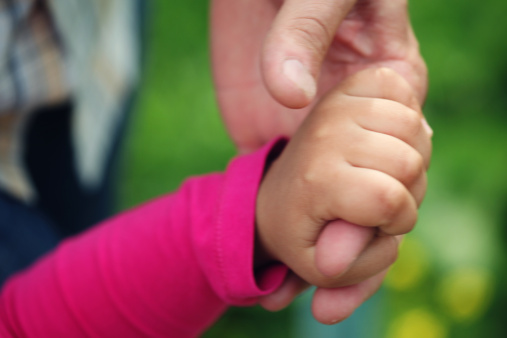 On lists of life stressors, divorce is usually ranked among the top two or three most emotionally challenging events. The process itself is experienced as highly stressful by many people, and from what we know about recovery from profound loss, it takes at least a year to begin to regain equilibrium. In other words, the stress caused by a divorce does not usually just go away when the decree is signed. Especially in situations in which there has been a high level of tension and acrimony during the divorce process, it can be very difficult to shift from conflict mode to co-parenting mode if there are children in the family.
On lists of life stressors, divorce is usually ranked among the top two or three most emotionally challenging events. The process itself is experienced as highly stressful by many people, and from what we know about recovery from profound loss, it takes at least a year to begin to regain equilibrium. In other words, the stress caused by a divorce does not usually just go away when the decree is signed. Especially in situations in which there has been a high level of tension and acrimony during the divorce process, it can be very difficult to shift from conflict mode to co-parenting mode if there are children in the family.
New sources of stress can arise post-decree, e.g. introducing children to new significant others, a parent’s decision to move, loss of a job, children struggling to adapt to the new normal. It is normal for these kinds of change to create uncertainty and distress.
When contemplating a divorce, many people turn to divorce professionals for ideas, advocacy and support. This can lessen feelings of isolation and uncertainty during a time of crisis. However, after the decree has been submitted to the court, people may feel they are on their own to pick themselves up and commence with the rest of their lives.
It has been my experience that specific post-decree support provided by neutral coaches and neutral child specialists can be an invaluable resource for families defining their new normal after a divorce. In the context of voluntary post decree alternative dispute resolution, resources can be shared, support given, and skills developed for effective co-parenting. Parenting and relationship plans can be created (if not completed during the divorce itself) or revised by joint agreement. In the context of voluntary alternative dispute resolution, children can be safely included in this process, e.g. to check in about their adjustment to new schedules and routines. It has been suggested that follow up care like this should be offered to all divorcing couples, though not all may need it.
This is not a replacement for psychotherapy. Individual therapy can enhance personal growth, provide support and help adults and children heal emotionally. Couples therapy specific to the end of marriage can help resolve lingering emotional issues and conflict. Family therapy may be valuable, especially if relationship repair between parents and children is needed. It is also not a replacement for support groups or resources like Daisy Camp. However, post-decree consultation with neutral experts who specialize in helping family members make the healthiest possible adjustment to a divorce can be a focused and powerful kind of support during a challenging time of transition.
 A strategy used by some divorcing spouses and their attorneys is to threaten that they will take the other spouse to court. Threatening court is a negotiation strategy in an effort to get the other side to give up or significantly compromise their position(s).
When attorneys use this tactic, they often will prepare for a trial. The trial preparation ends up being extremely expensive and emotionally exhausting for the involved spouses. Often a hatred for the other spouse develops because of trials and/or the threatened use of court.
The reality is a small fraction of divorces end up in trial. The overwhelming reason those cases do end up in trial is because spouses and their attorneys refuse to negotiate. Sometimes a spouse will tell their attorney to go for the throat or they say I want to make him/her pay. It is the divorcing spouses and unfortunately their children, if any, that end up paying the price financially and emotionally. Seeking revenge does not have a place in any divorce process and accompanied by an unwillingness to negotiate in good faith sets up a strategy to fail.
Collaborative divorce on the other hand takes the threatened use of court totally out of the picture. Both spouses are represented by their own collaboratively trained attorney. Spouses and attorneys alike commit in writing not to go to court. Conceptually this enhances the likelihood of reaching agreements by placing the spouses and their attorneys on the same side of the table in an effort to settle on all issues.
Let me ask you which process do you think provides both spouses with a potentially better outcome? Which process do you think you will have the most control over the outcome? Which process will give your children, if any, a better opportunity for future success by creating an effective co-parenting plan? Finally, which process will seek to minimize the stress both emotionally and financially for you and your spouse?
Download this free divorce knowledge kit showing a comparison chart between collaborative divorce and a court-based litigation process, case studies, and general information how a collaborative divorce may benefit you. Additional divorce resources can be found under the about us section at www.integrashieldfinancial.com. Remember to choose your process wisely.
A strategy used by some divorcing spouses and their attorneys is to threaten that they will take the other spouse to court. Threatening court is a negotiation strategy in an effort to get the other side to give up or significantly compromise their position(s).
When attorneys use this tactic, they often will prepare for a trial. The trial preparation ends up being extremely expensive and emotionally exhausting for the involved spouses. Often a hatred for the other spouse develops because of trials and/or the threatened use of court.
The reality is a small fraction of divorces end up in trial. The overwhelming reason those cases do end up in trial is because spouses and their attorneys refuse to negotiate. Sometimes a spouse will tell their attorney to go for the throat or they say I want to make him/her pay. It is the divorcing spouses and unfortunately their children, if any, that end up paying the price financially and emotionally. Seeking revenge does not have a place in any divorce process and accompanied by an unwillingness to negotiate in good faith sets up a strategy to fail.
Collaborative divorce on the other hand takes the threatened use of court totally out of the picture. Both spouses are represented by their own collaboratively trained attorney. Spouses and attorneys alike commit in writing not to go to court. Conceptually this enhances the likelihood of reaching agreements by placing the spouses and their attorneys on the same side of the table in an effort to settle on all issues.
Let me ask you which process do you think provides both spouses with a potentially better outcome? Which process do you think you will have the most control over the outcome? Which process will give your children, if any, a better opportunity for future success by creating an effective co-parenting plan? Finally, which process will seek to minimize the stress both emotionally and financially for you and your spouse?
Download this free divorce knowledge kit showing a comparison chart between collaborative divorce and a court-based litigation process, case studies, and general information how a collaborative divorce may benefit you. Additional divorce resources can be found under the about us section at www.integrashieldfinancial.com. Remember to choose your process wisely.  A strategy used by some divorcing spouses and their attorneys is to threaten that they will take the other spouse to court. Threatening court is a negotiation strategy in an effort to get the other side to give up or significantly compromise their position(s).
When attorneys use this tactic, they often will prepare for a trial. The trial preparation ends up being extremely expensive and emotionally exhausting for the involved spouses. Often a hatred for the other spouse develops because of trials and/or the threatened use of court.
The reality is a small fraction of divorces end up in trial. The overwhelming reason those cases do end up in trial is because spouses and their attorneys refuse to negotiate. Sometimes a spouse will tell their attorney to go for the throat or they say I want to make him/her pay. It is the divorcing spouses and unfortunately their children, if any, that end up paying the price financially and emotionally. Seeking revenge does not have a place in any divorce process and accompanied by an unwillingness to negotiate in good faith sets up a strategy to fail.
Collaborative divorce on the other hand takes the threatened use of court totally out of the picture. Both spouses are represented by their own collaboratively trained attorney. Spouses and attorneys alike commit in writing not to go to court. Conceptually this enhances the likelihood of reaching agreements by placing the spouses and their attorneys on the same side of the table in an effort to settle on all issues.
Let me ask you which process do you think provides both spouses with a potentially better outcome? Which process do you think you will have the most control over the outcome? Which process will give your children, if any, a better opportunity for future success by creating an effective co-parenting plan? Finally, which process will seek to minimize the stress both emotionally and financially for you and your spouse?
Download this free divorce knowledge kit showing a comparison chart between collaborative divorce and a court-based litigation process, case studies, and general information how a collaborative divorce may benefit you. Additional divorce resources can be found under the about us section at www.integrashieldfinancial.com. Remember to choose your process wisely.
A strategy used by some divorcing spouses and their attorneys is to threaten that they will take the other spouse to court. Threatening court is a negotiation strategy in an effort to get the other side to give up or significantly compromise their position(s).
When attorneys use this tactic, they often will prepare for a trial. The trial preparation ends up being extremely expensive and emotionally exhausting for the involved spouses. Often a hatred for the other spouse develops because of trials and/or the threatened use of court.
The reality is a small fraction of divorces end up in trial. The overwhelming reason those cases do end up in trial is because spouses and their attorneys refuse to negotiate. Sometimes a spouse will tell their attorney to go for the throat or they say I want to make him/her pay. It is the divorcing spouses and unfortunately their children, if any, that end up paying the price financially and emotionally. Seeking revenge does not have a place in any divorce process and accompanied by an unwillingness to negotiate in good faith sets up a strategy to fail.
Collaborative divorce on the other hand takes the threatened use of court totally out of the picture. Both spouses are represented by their own collaboratively trained attorney. Spouses and attorneys alike commit in writing not to go to court. Conceptually this enhances the likelihood of reaching agreements by placing the spouses and their attorneys on the same side of the table in an effort to settle on all issues.
Let me ask you which process do you think provides both spouses with a potentially better outcome? Which process do you think you will have the most control over the outcome? Which process will give your children, if any, a better opportunity for future success by creating an effective co-parenting plan? Finally, which process will seek to minimize the stress both emotionally and financially for you and your spouse?
Download this free divorce knowledge kit showing a comparison chart between collaborative divorce and a court-based litigation process, case studies, and general information how a collaborative divorce may benefit you. Additional divorce resources can be found under the about us section at www.integrashieldfinancial.com. Remember to choose your process wisely. 

 Divorce is a challenging life experience for children, and parents worry what the impact will be on their children’s lives. Based on my work with families of divorce, I have three specific suggestions for how parents can empathetically support their children during this difficult and often painful transition:
1. Never put your children in the middle of parental conflict.
This cannot be overstated: exposure to parental conflict is toxic for children. Heated arguments around children, even if parents believe their children can’t overhear, negatively charge the environment in the home, and kids will feel it. Critical or disrespectful words about a parent said by the other parent in the hearing range of their children make kids confused, sad and often angry. I have heard many stories from tearful children about trying to get parents to stop arguing and belittling each other. You would never feed your children poisonous food; do not make them absorb poisonous words.
2. Remember that children deserve the best safe parenting they can get from both parents.
Be civil, treat each other with courtesy and remind your children that both parents love them. Despite your hurt, anger or betrayal as a spouse, remember that your child’s relationship with and feelings about your soon-to-be-ex are separate from yours. Resist the urge to try to get your child on your side, or to alienate your child from the other parent. Of course real safety concerns must be addressed and may result in protective measures like supervised parental access. But it is not fair to try to negatively manipulate your child’s feelings about the other parent just because you are angry.
3. Listen to your children and stay attuned to their needs.
The emotional and time demands of a divorce can understandably absorb parents’ time and attention at the exact time their children may need extra reassurance. Because regular routines are usually reassuring to children, try to designate time to spend with your children doing normal family activities. Let them know whatever feelings they have about the divorce are okay, and you will always love and support them. Check in with them to see how they’re doing, but read their cues if they tell you you’re asking too often.
Divorce is a challenging life experience for children, and parents worry what the impact will be on their children’s lives. Based on my work with families of divorce, I have three specific suggestions for how parents can empathetically support their children during this difficult and often painful transition:
1. Never put your children in the middle of parental conflict.
This cannot be overstated: exposure to parental conflict is toxic for children. Heated arguments around children, even if parents believe their children can’t overhear, negatively charge the environment in the home, and kids will feel it. Critical or disrespectful words about a parent said by the other parent in the hearing range of their children make kids confused, sad and often angry. I have heard many stories from tearful children about trying to get parents to stop arguing and belittling each other. You would never feed your children poisonous food; do not make them absorb poisonous words.
2. Remember that children deserve the best safe parenting they can get from both parents.
Be civil, treat each other with courtesy and remind your children that both parents love them. Despite your hurt, anger or betrayal as a spouse, remember that your child’s relationship with and feelings about your soon-to-be-ex are separate from yours. Resist the urge to try to get your child on your side, or to alienate your child from the other parent. Of course real safety concerns must be addressed and may result in protective measures like supervised parental access. But it is not fair to try to negatively manipulate your child’s feelings about the other parent just because you are angry.
3. Listen to your children and stay attuned to their needs.
The emotional and time demands of a divorce can understandably absorb parents’ time and attention at the exact time their children may need extra reassurance. Because regular routines are usually reassuring to children, try to designate time to spend with your children doing normal family activities. Let them know whatever feelings they have about the divorce are okay, and you will always love and support them. Check in with them to see how they’re doing, but read their cues if they tell you you’re asking too often.  On lists of life stressors, divorce is usually ranked among the top two or three most emotionally challenging events. The process itself is experienced as highly stressful by many people, and from what we know about recovery from profound loss, it takes at least a year to begin to regain equilibrium. In other words, the stress caused by a divorce does not usually just go away when the decree is signed. Especially in situations in which there has been a high level of tension and acrimony during the divorce process, it can be very difficult to shift from conflict mode to co-parenting mode if there are children in the family.
On lists of life stressors, divorce is usually ranked among the top two or three most emotionally challenging events. The process itself is experienced as highly stressful by many people, and from what we know about recovery from profound loss, it takes at least a year to begin to regain equilibrium. In other words, the stress caused by a divorce does not usually just go away when the decree is signed. Especially in situations in which there has been a high level of tension and acrimony during the divorce process, it can be very difficult to shift from conflict mode to co-parenting mode if there are children in the family.




